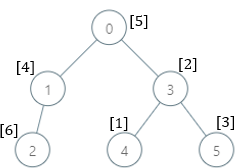Problem
There is a family tree rooted at 0 consisting of n nodes numbered 0 to n - 1. You are given a 0-indexed integer array parents, where parents[i] is the parent for node i. Since node 0 is the root, parents[0] == -1.
There are 10^5 genetic values, each represented by an integer in the inclusive range [1, 10^5]. You are given a 0-indexed integer array nums, where nums[i] is a **distinct **genetic value for node i.
Return **an array *ans* of length n where ans[i] is** **the *smallest* genetic value that is missing from the subtree rooted at node** i.
The subtree rooted at a node x contains node x and all of its descendant nodes.
Example 1:

Input: parents = [-1,0,0,2], nums = [1,2,3,4]
Output: [5,1,1,1]
Explanation: The answer for each subtree is calculated as follows:
- 0: The subtree contains nodes [0,1,2,3] with values [1,2,3,4]. 5 is the smallest missing value.
- 1: The subtree contains only node 1 with value 2. 1 is the smallest missing value.
- 2: The subtree contains nodes [2,3] with values [3,4]. 1 is the smallest missing value.
- 3: The subtree contains only node 3 with value 4. 1 is the smallest missing value.
Example 2:

Input: parents = [-1,0,1,0,3,3], nums = [5,4,6,2,1,3]
Output: [7,1,1,4,2,1]
Explanation: The answer for each subtree is calculated as follows:
- 0: The subtree contains nodes [0,1,2,3,4,5] with values [5,4,6,2,1,3]. 7 is the smallest missing value.
- 1: The subtree contains nodes [1,2] with values [4,6]. 1 is the smallest missing value.
- 2: The subtree contains only node 2 with value 6. 1 is the smallest missing value.
- 3: The subtree contains nodes [3,4,5] with values [2,1,3]. 4 is the smallest missing value.
- 4: The subtree contains only node 4 with value 1. 2 is the smallest missing value.
- 5: The subtree contains only node 5 with value 3. 1 is the smallest missing value.
Example 3:
Input: parents = [-1,2,3,0,2,4,1], nums = [2,3,4,5,6,7,8]
Output: [1,1,1,1,1,1,1]
Explanation: The value 1 is missing from all the subtrees.
Constraints:
n == parents.length == nums.length2 <= n <= 10^50 <= parents[i] <= n - 1fori != 0parents[0] == -1parentsrepresents a valid tree.1 <= nums[i] <= 10^5Each
nums[i]is distinct.
Solution
class Solution {
public int[] smallestMissingValueSubtree(int[] parents, int[] nums) {
int[] ans = new int[parents.length];
Node[] all = new Node[parents.length];
int max = 0;
for (int i = 0; i < nums.length; i++) {
all[i] = new Node(i, nums[i]);
max = Math.max(max, nums[i]);
}
for (int i = 1; i < parents.length; i++) {
all[parents[i]].nodes.add(all[i]);
}
solve(all[0], ans, new UF(++max, nums));
return ans;
}
private void solve(Node root, int[] ans, UF uf) {
int max = 1;
for (Node child : root.nodes) {
solve(child, ans, uf);
uf.union(root.val, child.val);
max = Math.max(ans[child.idx], max);
}
while (max <= ans.length && uf.isConnected(max, root.val)) {
++max;
}
ans[root.idx] = max;
}
private static class Node {
int idx;
int val;
List<Node> nodes;
Node(int idx, int val) {
this.idx = idx;
this.val = val;
nodes = new ArrayList<>();
}
}
private static class UF {
int[] rank;
int[] parent;
UF(int n, int[] nums) {
rank = new int[n];
parent = new int[n];
for (int m : nums) {
parent[m] = m;
}
}
private int find(int x) {
if (x == parent[x]) {
return x;
}
parent[x] = find(parent[x]);
return parent[x];
}
private void union(int x, int y) {
x = find(x);
y = find(y);
if (rank[x] > rank[y]) {
parent[y] = x;
} else {
parent[x] = y;
if (rank[x] == rank[y]) {
rank[y]++;
}
}
}
private boolean isConnected(int x, int y) {
return find(x) == find(y);
}
}
}
Explain:
nope.
Complexity:
- Time complexity : O(n).
- Space complexity : O(n).